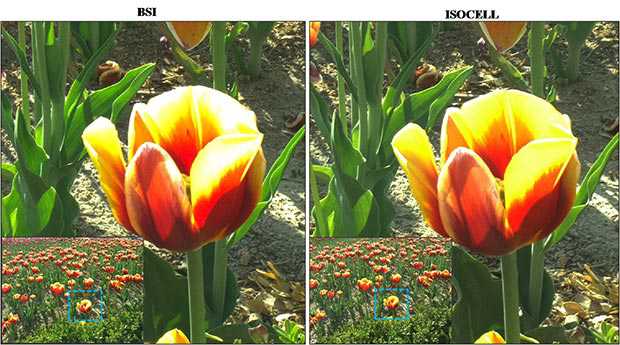Da alcuni anni i produttori di dispositivi mobile hanno capito l’importanza delle fotocamere in questi dispositivi e quanto queste sia sfruttate dagli utenti che sempre più rinunciano a macchine fotografiche e videocamera in favore di un dispositivo all-in-one, dando vita ad una lunga “battaglia” tecnologica per sviluppare fotocamere sempre migliori, con Nokia che con la propria serie Lumia ha capito in anticipo l’evolversi della situazione realizzando prodotto eccellenti e aggiudicandosi svariati premi ma che in questi mesi è stata incalzata da Sony, Apple, Samsung ed altri produttori che hanno rilasciato prodotti veramente interessanti ed incentrati su fotocamere di qualità, tanto da far coniare la terminologia cameraphone per indicare smartphone con apparati fotografici di primo livello.
E proprio Samsung in queste ore ha annunciato di aver sviluppato una nuova tecnologia chiamata ISOCELL che incrementerà la sensibilità alla luce garantendo scatti con colori e contrasto migliori anche in condizioni di scarsa illuminazione. Samsung dovrebbe introdurre la tecnologia ISOCELL in smartphone e tablet top di gamma a partire dal prossimo anno.
Samsung ha fatto un notevole salto in avanti in questi anni passando prima dalla tecnologia FSI alla BSI e ora a questa ISOCELL, che la casa produttrice afferma permetta una riduzione del disturbo di circa il 30% con una migliore riproduzione dei colori, nitidezza e ricchezza rispetto alla tecnologia BSI.
La tecnologia ISOCELL permetterà inoltre di realizzare sensori ancora più sottili rispetto al passato.
Il primo sensore realizzato da Samsung ad adottare la nuova tecnologia è il S5K4H5YB da 8 megapixel che utilizza pixel ISOCELL da 1.12um e come detto debutterà il prossimo anno.
Vi lasciamo con il comunicato (Inglese) ufficiale di Samsung sulla tecnologia ISOCELL:
[expand title=”Samsung Launches ISOCELL”]
Samsung Launches ISOCELL: Innovative Image Sensor Technology for Premium Mobile Devices
New 8-megapixel sensor is the first to sample with the ISOCELL technology applied
SEOUL, South Korea–(BUSINESS WIRE)–Samsung Electronics Co., Ltd., a world leader in advanced semiconductor solutions, today announced its new advanced pixel technology for CMOS image sensors, ISOCELL. This new technology substantially increases light sensitivity and effectively controls the absorption of electrons, resulting in higher color fidelity even in poor lighting conditions. ISOCELL improves the image quality and enhances the user experience of premium smartphones and tablets that integrate sensors with this exciting new technology.
“Through advances in pixel and process technology, smartphone and tablet cameras have made it easier than ever for consumers to capture and share beautiful, clear images with the world,” said Taehoon Kim, vice president of System LSI marketing, Samsung Electronics. “ISOCELL technology is yet another innovation that significantly raises the bar in image quality, and demonstrates Samsung’s technology leadership in image sensors for mobile devices.”
The quality of an image sensor is determined by the amount of light that is accurately captured by the individual pixels within the sensor array. With the market pressure to increase camera resolution and image quality, without growing the camera size, the pixels have had to shrink, while improving their performance at the same time – a challenging task.
To meet this challenge, previous sensor technology developments focused on improving the light absorption of each pixel, and have progressed pixel technology from FSI (Front Side Illumination) to BSI (Back Side Illumination) which places photodiode at the top to maximize photoelectric efficiency. While being very effective at the time, this BSI technology also faced limitations in improving image quality as pixel sizes continued to decrease.
Building on these past advances and continuing the push toward higher quality image sensors for mobile devices, Samsung has developed ISOCELL the next generation of pixel technology, which is patent pending. ISOCELL technology forms a physical barrier between neighboring pixels – isolating the pixel. This isolation enables more photons to be collected from the micro-lens and absorbed into the correct pixel’s photodiode minimizing undesired electrical crosstalk between pixels and allowing expanded full well capacity (FWC).
Compared to conventional BSI pixels, the ISOCELL pixels decrease the crosstalk by approximately 30 percent which results in higher color fidelity to reproduce the original color with sharpness and richness, and increase the full well capacity (FWC) by 30 percent which leads to greater dynamic range.
Additionally, an imager designed with ISOCELL can feature a 20 percent wider chief ray angle (CRA), reducing the height of the camera module. This makes it suitable for slim and small form factor mobile devices with challenging low z-height requirements.
As the first Samsung image sensor to adopt this new technology, the S5K4H5YB 8Megapixel imager utilizes a 1.12um ISOCELL pixel and has a 1/4inch optical format. The S5K4H5YB is currently sampling to customers with mass production scheduled for Q4 2013.
According to market research firm Techno System Research, in 2014, approximately 66 percent of smartphones will feature image sensors with 8Mp or higher resolution.
[/expand]



